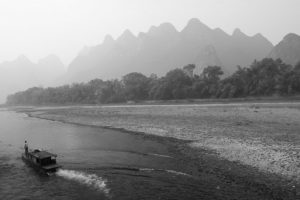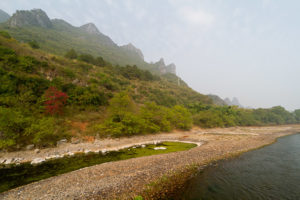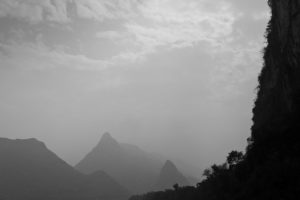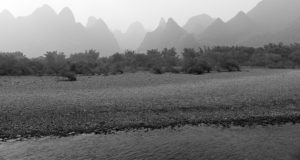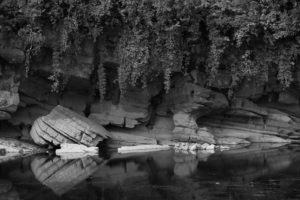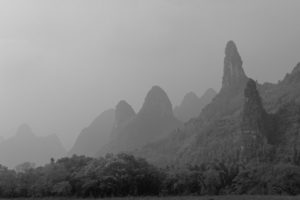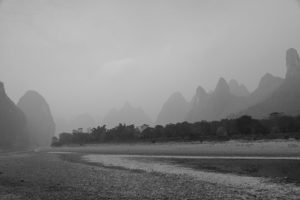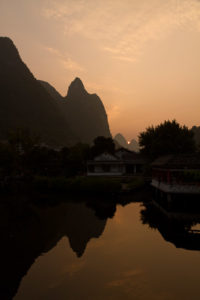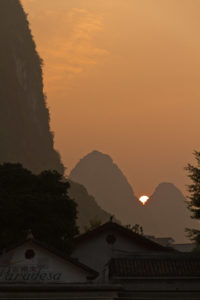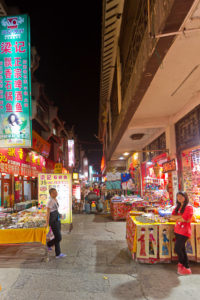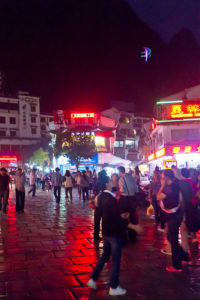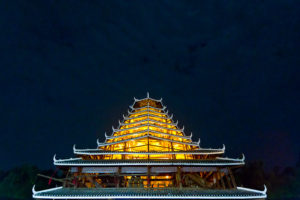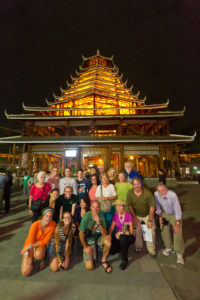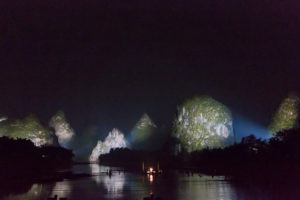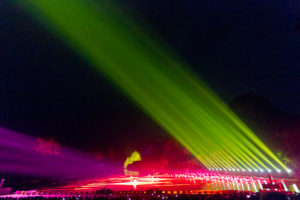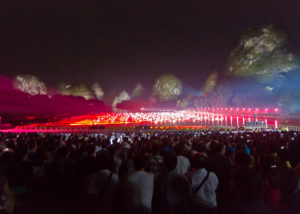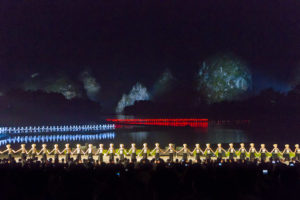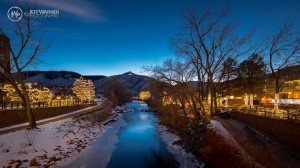After being out late again the previous night, I decided to forego the morning ‘sunrise’ images in deference for sleeping a bit and getting packed, as we were to leave Guilin via the Li River Cruise, to spend the night in town of Yanghshuo. The 85 kilometer river route to Yangshuo would take us past some of the most spectacular scenery of any country in the world, and the Li River was touted as the primary attraction of this four day trip.
The dock at Zhu Jiang bustled with hundreds of people boarding large-ish ferries, shallow-bottomed, multi-level boats holding something north of 100 passengers each. Our group was called and we quickly boarded and shoved off. The 24 of us shared the boat with a variety of other tourists (many of whom appeared Chinese), and space on the top deck quickly became crowded with people wanting an unimpeded view of the intriguing landscape along the Li River. Once again, the ‘weather’ (term used quite loosely) consisted of poor visibility, with temps above 70.
[rant] OK, I’ll just come out and say it: as most of the world was able to vicariously witness during the Beijing Olympics, China’s air quality is quite simply horrendous, surely a result of the abundant coal-fired power plants that have sprung up over the last several decades. China’s 1.8+ billion people has a rapidly growing population of middle-income wage-earners, and as development rapidly spreads, the government approaches some of the energy requirements utilizing less-sustainable solutions than the rest of the world might otherwise prefer. That being said, the U.S. pours more carbon into the atmosphere, per capita, than any other nation on the planet. China’s population, however, is poised to potentially dwarf the rest of the world in both energy and resource consumption if the government doesn’t take environmental issues into account, which it appears to be doing as of late. [/rant]
Alan and I hung out up top with Michele Boudrias, the Oceanography professor from the University of San Diego, a funny Canuck whose class I wish I’d been able to sit in on, my aspirations having been thwarted by the 5-week crud I came down with in Montreal. As the boat progressed downstream it occasionally scraped the shallow river bottom (apparently common due to winter’s lack of rainfall), though this year occurring earlier in the season than normal. Visibility was a few miles, but variable. In some places it seemed that one side of a peak was actually hazier than the other, and visibility seemed to vacillate up and down throughout the day. Peaks as high as 300 meters became more numerous as we continued, with very rocky shorelines and graveldings :). We ran across some ladies digging 1-2 meter-deep holes, shovel-fulls of rock cobbles being thrown out of the hole onto a wooden-framed sieve. Puzzled, I asked our guide what they were looking for, and he indicated they were actually digging for sand, which was not abundant in this limestone environment. Wow, now that’s some labor!
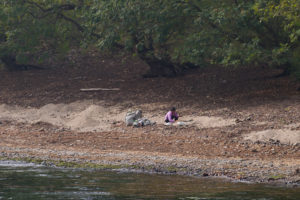 |
| Sieving sand from the shore of the Li River. |
As we passed the Xingping ferry port about midway, the scenery started to get more dramatic with many ‘named’ formations jutting hundreds of meters straight out of the water. We saw a couple of Cormorant fishermen paddling boats with 3 or 4 cormorants attached to lines, rings around their necks to prevent them from swallowing fish (and I thought Vietnamese ‘electric-shock’ fishing was ingenious; or is it merely lazy to make the birds do all the work?). I’ll leave the rest of the scenery to the images despite the harshness of the overhead sun, which imparted an irregularity to the light that was hard to find compelling.
 |
| Kevin, with a 20-yuan bill, featuring the scene in the background. |
 |
| A cormorant fisherman. |
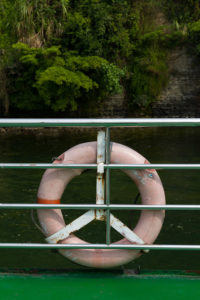 |
| Peace out. |
Upon arrival in Yangshuo, the normal ferry port could not be used due to the low river level, ‘conveniently’ requiring a walk of 500 meters down a pathway jammed on all sides by vendors selling the same stuff we’d seen in both Guilin and Longsheng. The 23 of us–along with what seemed like several thousand Chinese tourists–all meandered down the same 5-meter wide walkway, with some of our group being Lifelong Learners (the group of older people on the ship), some of whom weren’t particularly fast nor agile in the chaos. Once we got to the street, unfortunately one of the Lifelong Learners got sideswiped by a motor scooter, though thankfully she didn’t appear too terribly hurt. A shouting match ensued between our guide and the scooter-driver, who appeared to be suggesting that it wasn’t his fault. Alan and several others spent the next several hours taking her to two hospitals for a shoulder x-ray to ensure she was OK (the scooter-driver had been detained and apparently is legally responsible for her medical bills, clearly the source of his rather vociferous objections).
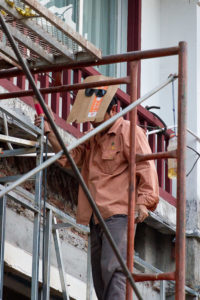 |
| Nice welder’s mask! |
The rest of us walked through the quaint little town to Ai Yuan Hotel on West Street, yet another self-professed ‘biggest market in the world’. We found our luggage in the lobby, with a net tossed over it to prevent any of it from walking off. I quickly dropped my bag in the room and then walked West Street, a wonderful mix of restaurants, vendors and shops, all dramatically set beneath steep-sided limestone peaks in all directions. As beautiful as Guilin was, this mere ‘town’ of 60,000 was simply spectacular, in all respects. As I came upon a McDonald’s with perhaps one of the most incredible locations in the entire world, I snapped a picture of ten or so people about 50 meters away on a footbridge, all pointing their cameras the same direction.
About the time the shutter clicked my stupidity dawned on me, and, flip-flops a-flappin’, 20 seconds later found me standing on the footbridge, pointing my camera westward into the warm sunset, the orange disk of the sun having justdescended onto the horizon, perfectly situated between two spires above, a reflecting pond below. What might be a once-in-a-lifetime opportunity to see the sun set in such a wondrous place as this could have been thwarted by any number of different turns along my path down West Street. Curiously, McDonald’s proved the ‘visual catalyst’ to my getting to the one place in the vicinity where it could be viewed. All of 90 seconds and 16 images later, the sun was gone, the impromptu other-worldly show over, the monotone nature of the atmosphere resuming. I realized only later while reviewing the pictures that the building standing above the reflecting pond had a sign on it, which read: ‘Paradesa’.
As much as I’d typically try to seize such opportune pieces of text as closure of blog posts, I can’t due to the positively spectacular show we witnessed later that night, set beneath a landscape more remarkable even than the Colorado music venue, Red Rocks Amphitheater. If you recall the Beijing Olympics’ incredible opening and closing shows, the director of those spectacles has been running a show called ‘Impression Sanjie Liu’ since 2004, with the backdrop the karst pinnacles along the Li River. 600 people are involved in this earthscape/visual show presented once or twice daily, and the limestone peaks 1+ km behind are completely devoid of ambient light, then alternately lit up with lights, while six hundred people perform in a huge reflecting pond of the Li River in the foreground. Canoes and moving, floating walkways are used, with various visual effects like long lengths of fabric, LED-lit costumes, music, singing, and stories told in Chinese. All I can say is WOW, and I was kicking myself for not dragging a tripod with me for this visual and aural feast.

